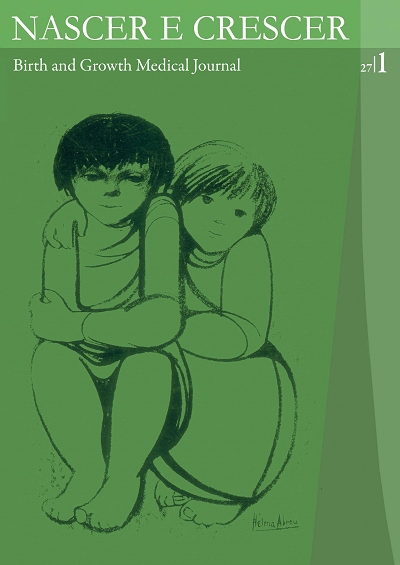Children and media exposure
DOI:
https://doi.org/10.25753/BirthGrowthMJ.v27.i1.9510Keywords:
Adolescents, children, mediaAbstract
Background: Children and adolescents spend several hours watching television, playing video games and surfing the internet. Benefits of media are vast, but potential risks exist.
Objectives: Determine the patterns of media exposure in a population of children and adolescents.
Methods: This is a cross-sectional, observational and analytic study. We selected a convenience sample from children and adolescents between 4 months and 18 years who were observed in a primary healthcare center and a questionnaire was applied to the caregivers.
Results: One hundred and twenty six questionnaires were obtained. A significant percentage of children and adolescents were exposed to more than two hours a day of screen time at weekdays and weekend: television - 15,9% and 50,4%, video games - 6,3% and 15,9% and computer - 10,3% and 22,2%, respectively. A considerable number of children under two years of age is exposed to one hour or more of television a day at weekdays (21,4%) and weekend (32,1%). Sixty-nine point six percent of caregivers reported using television or tablet at mealtimes. The presence of media in the bedroom was associated with greater exposure to television at weekdays (p=0,026 and p=0,005, respectively). Habits of caregivers related to the media were associated with increased exposure of children and adolescents to television at weekend (p=0,004). Screen time seemed to be significantly associated with reduced sleep duration.
Conclusions: Exposure to media is growing and occurs at increasingly earlier ages. This issue should be addressed in medical appointments, in order to advise parents.
Downloads
References
Pereira M, Costa C, Passadouro R, Spencer B. Como dormem as nossas crianças? Hábitos de televisão e perturbações de sono na idade escolar. Revista Saúde Infantil 2007; 29: 53-9.
Mendes P, Fernandes A. A Criança e a Televisão. Acta Pediatr Port 2003; 34:101-4.
American Academy of Pediatrics, Council on Communications and Media. Media Education. Pediatrics 2010; 126:1012-7.
American Academy of Pediatrics, Committee on Public Education. Children, Adolescents, and Television. Pediatrics 2001; 107: 423-6.
Strasburger VC, Jordan AB, Donnerstein E. Health effects of media on children and adolescents. Pediatrics 2010; 125:756-67.
American Academy of Pediatrics, Council on Communications and Media. Policy Statement-Media Violence. Pediatrics 2009; 124:1495-503.
Robinson T, Chen H, Killen J. Television and Music Video Exposure and Risk of Adolescent Alcohol Use. Pediatrics 1998; 102:1-6.
Strasburger VC. American Academy of Pediatrics. Council on Communications and Media. Policy statement - Children, adolescents, substance abuse and the media. Pediatrics 2010; 126:791-9.
Stamatakis E, Coombs N, Jago R, Gama A, Mourão I, Nogueira H, et al. Associations between indicators of screen time and adiposity indices in Portuguese children. Prev Med 2013; 56:299–303.
Hale L, Guan S. Screen time and sleep among school-aged children and adolescents: A systematic literature review. Sleep Medicine Reviews 2015; 21:50-8.
Ahn YM, Williamson AA, Seo HJ, Sadeh A, Mindell JA. Sleep patterns among South Korean Infants and Toddlers: Global Comparison. J Korean Med Sci 2016; 31:261-9.
Cespedes EM, Gillman MW, Kleinman K, Rifas-Shiman SL, Redline S, Taveras EM. Television Viewing, Bedroom Television, and Sleep Duration From Infancy to Mid-Childhood. Pediatrics 2014;133:e1163-e1171. doi:10.1542/peds.2013-3998.
Council on Communications and Media, Brown A. Media Use by Children Younger Than 2 Years. Pediatrics 2011; 128:1040-5.
Lampard A, Jurkowski J, Davison K. Social-Cognitive Predictors of Low-Income Parents’ Restriction of Screen Time Among Preschool-Aged Children. Health Educ Behav 2012; 40:526-30.
Bleakley A, Piotrowski J, Hennessy M, Jordan M. Predictors of parents’ intention to limit children’s television Viewing. J Public Health (Oxf) 2013; 35:525-32.
Carson V, Janssen I. Volume, patterns, and types of sedentary behavior and cardio-metabolic health in children and adolescents: a cross-sectional study. BMC Public Health 2011; 11:274.
Monteiro MB. Meios de Comunicação Social e construção da realidade social: crescer com a violência televisiva. In: Stress e Violência na Criança e no Jovem. Lisboa: João Gomes-Pedro ed.; 1999:153-74.
Jago R, Stamatakis E, Gama A, Carvalhal IM, Nogueira H, Rosado V, et al. Parent and child screen-viewing time and home media environment. Am J Prev Med. 2012; 43: 150-8.
Mukherjee SB, Gupta Y, Aneja S. Study of Television Viewing Habits in Children. Indian J Pediatr 2014. doi:10.1007/s12098-014-1398-3.
Funk JB, Brouwer J, Curtiss K, McBroom E. Parents of Preschoolers: Expert Media Recommendations and Ratings Knowledge, Media-Effects Beliefs, and Monitoring Practices. Pediatrics 2009; 123:981-8. doi: 10.1542/peds.2008-1543.
Zimmerman FJ, Christakis DA, Meltzoff AN. Television and DVD/Video Viewing in Children Younger than 2 years. Arch Pediatr Adolesc Med 2007;161:473-9.
Bleakley A, Jordan AB, Hennessy M. The Relationship Between Parents’ and Children’s Television Viewing. Pediatrics 2013; 132:e364-e371. doi:10.1542/peds.2012-3415.
Karaagac AT. Undesirable Effects of Media on Children: Why Limitations is Necessary?. Indian Pediatrics 2015; 52:469-471.
Robinson S, Daly RM, Ridgers ND, Salmon J. Screen-Based Behaviors of Children and Cardiovascular Risk Factors. J Pediatr 2015; 167:1239-45.
Downloads
Published
How to Cite
Issue
Section
License
Copyright and Authors' Rights
All articles published in Nascer e Crescer - Birth and Growth Medical Journal are Open Access and comply with the requirements of funding agencies or academic institutions. For use by third parties, Nascer e Crescer - Birth and Growth Medical Journal adheres to the terms of the Creative Commons License "Attribution - Non-Commercial Use (CC-BY-NC)".
It is the author's responsibility to obtain permission to reproduce figures, tables, etc. from other publications.
Authors must submit a Conflict of Interest statement and an Authorship Form with the submission of the article. An e-mail will be sent to the corresponding author confirming receipt of the manuscript.
Authors are permitted to make their articles available in repositories at their home institutions, provided that they always indicate where the articles were published and adhere to the terms of the Creative Commons license.


